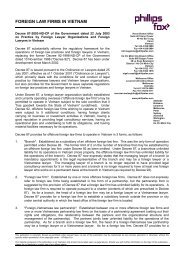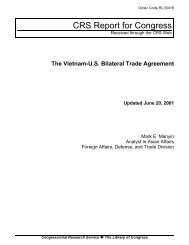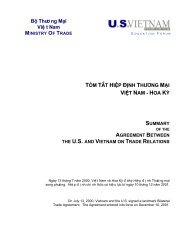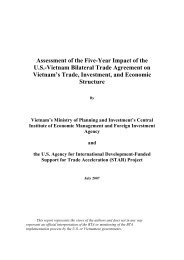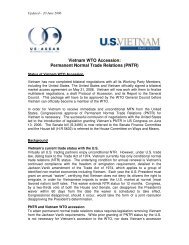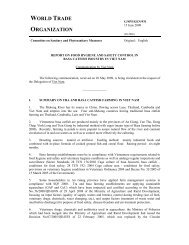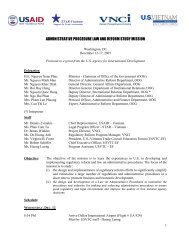Climate risks and adaptation in Asian coastal megacities: A synthesis
Climate risks and adaptation in Asian coastal megacities: A synthesis
Climate risks and adaptation in Asian coastal megacities: A synthesis
- No tags were found...
Create successful ePaper yourself
Turn your PDF publications into a flip-book with our unique Google optimized e-Paper software.
measures capture a number of important values (levelof economic development, extent of <strong>in</strong>dustrial activities,transportation system, water supply, dra<strong>in</strong>age,etc). To calculate costs us<strong>in</strong>g this method, a numberof important assumptions were <strong>in</strong>tegrated <strong>in</strong>to theanalysis: Areas subject to flood<strong>in</strong>g lose all theirproductivity for the duration of the flood. The GDPproduced <strong>in</strong> a particular area is directly proportionateto population (i.e. if an area accounts for 1 percent ofthe population it will also account for 1 percent of theGDP). GDP is produced evenly over time (i.e. with1/365th of annual GDP be<strong>in</strong>g produced everyday).Based on GSO statistics, GDP growth will average11.5 percent between 2006–10; 8.7 percent between2011–25; <strong>and</strong> 8 percent between 2026–50. Populationgrowth will take place <strong>in</strong> l<strong>in</strong>e with the high estimatediscussed <strong>in</strong> chapter 4. Future values are discountedat an annual rate of 10 percent. 26Given these assumptions <strong>and</strong> the <strong>in</strong>formationon flood<strong>in</strong>g derived from the HydroGIS models, anestimation of the costs due to flood<strong>in</strong>g is relativelystraightforward. For each district <strong>and</strong> for each yearuntil 2050, the follow<strong>in</strong>g calculation was performed:Annual costof flood<strong>in</strong>g=Number of days the district is flooded xnumber of people affected x GDP/capita/dayThe annual cost of flood<strong>in</strong>g was calculatedfor each year between 2006 <strong>and</strong> 2050, <strong>and</strong> the discountedcosts summed for the whole period. TheHCMC study presents results from both the l<strong>and</strong>values <strong>and</strong> GDP measures. The differences <strong>in</strong> theresults <strong>and</strong> approaches are discussed <strong>in</strong> chapter 4.Assumptions aboutthe Future of Cities <strong>in</strong>Estimat<strong>in</strong>g Damage CostsCities <strong>in</strong> 2050 are likely to be vastly different fromtoday’s cities. Underst<strong>and</strong><strong>in</strong>g how different is ahuge task <strong>and</strong> there is no attempt to model economicgrowth <strong>and</strong> l<strong>in</strong>k it to urban development. Instead,exist<strong>in</strong>g data <strong>and</strong> official plans <strong>and</strong> projections areused to underst<strong>and</strong> <strong>and</strong> develop GIS-based maps.Further, <strong>in</strong> assess<strong>in</strong>g damage costs, each city studymade assumptions about population size <strong>and</strong> distribution,poverty, economic growth <strong>and</strong> city-specificgross domestic product, urbanization, flood <strong>and</strong>transportation <strong>in</strong>frastructure, <strong>and</strong> spontaneous<strong>adaptation</strong> <strong>and</strong> migration. Where possible, theybuilt on exist<strong>in</strong>g plans <strong>and</strong> studies undertaken bycity governments related to urban growth, publicutilities <strong>and</strong> transportation networks, <strong>and</strong> so forth.Population <strong>in</strong> 2050 is estimated based on the bestavailable local projections for each city. The populationdistribution with<strong>in</strong> each city <strong>in</strong> 2050 buildson available estimates of population density <strong>and</strong>distribution <strong>and</strong> some underst<strong>and</strong><strong>in</strong>g of futurepopulation dynamics. Economic growth <strong>and</strong> povertyprojected <strong>in</strong> 2050 varies across the case studies.These assumptions are made explicit <strong>in</strong> the follow<strong>in</strong>gchapters with respect to each city.Human spontaneous <strong>adaptation</strong> to the possibilityof <strong>in</strong>creased flood<strong>in</strong>g is considered but is notfully <strong>in</strong>corporated <strong>in</strong>to the studies. This is partlybecause of the difficulties <strong>in</strong> predict<strong>in</strong>g <strong>adaptation</strong>behavior <strong>and</strong> partly because populations, whilelikely to respond to <strong>in</strong>cremental change, may nothave a measured response to the type of extremeevents considered <strong>in</strong> this study. 27 The case studiesdo take <strong>in</strong>to account human migration <strong>in</strong> identify<strong>in</strong>gpopulation distribution <strong>in</strong> 2050. In general, populationsexposed to flood<strong>in</strong>g are likely to cont<strong>in</strong>ue tobe exposed to flood<strong>in</strong>g except <strong>in</strong> cases where thereis improved flood <strong>in</strong>frastructure put <strong>in</strong>to place.Assumptions about pricesGiven difficulties <strong>in</strong> estimat<strong>in</strong>g future prices, allthe three case studies largely keep the real value ofgoods <strong>and</strong> services unchanged. The Bangkok studyestimates the costs of damage <strong>in</strong> 2008 us<strong>in</strong>g current26Because <strong>in</strong> the case of l<strong>and</strong>, the l<strong>and</strong> value already representsthe discounted future <strong>in</strong>come stream capitalized <strong>in</strong>l<strong>and</strong> value, so there is no need for discount<strong>in</strong>g when us<strong>in</strong>gl<strong>and</strong> values to estimate the cost of climate change <strong>in</strong> the previousanalysis.27Yohe et al. (1995), for example, argue that if permanent<strong>in</strong>undation is expected due to SLR, it might be appropriate<strong>in</strong> cost-benefit analyses to treat the value of <strong>in</strong>undatedbuild<strong>in</strong>gs as zero or very low. If there is full <strong>in</strong>formation <strong>and</strong>efficient <strong>adaptation</strong>, economic agents can be expected to letthese build<strong>in</strong>gs fully depreciate before they are <strong>in</strong>undated.In our study, we do not assume full <strong>in</strong>formation. Nonetheless,rational households who can afford to move are likelyto move away from flood-prone areas, which may be thenpopulated by poorer communities.Methodologies for Downscal<strong>in</strong>g, Hydrological Mapp<strong>in</strong>g, <strong>and</strong> Assess<strong>in</strong>g Damage Costs | 19



